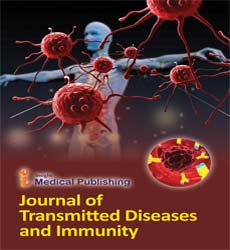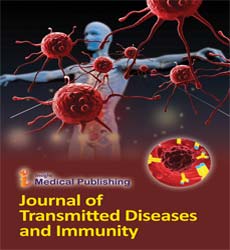ISSN : 2573-0320
Journal of Transmitted Diseases and Immunity
Immune system - Major Histocompatibility Complex and its Function
Ranjan Das*
Department of Clinical Sciences, College of Medicine, University of Sharjah, Sharjah, United Arab Emirates
- *Corresponding Author:
- Ranjan Das
Department of Clinical Sciences, College of Medicine, University of Sharjah, Sharjah, United Arab Emirates
E-mail: ranjandedu@gmail.com
Received Date: September 14, 2021; Accepted Date: September 29, 2021; Published Date: October 06, 2021
Citation: Das R (2021) Immune system- Major Histocompatibility Complex and its Function. J Transm Dis Immun. Vol.5 No.5:46.
Commentary
Major Histocompatibility Complex (MHC), team of genes that code for proteins discovered on the surfaces of cells that assist the immune device understand overseas substances. MHC proteins are discovered in all greater vertebrates. In human beings the complex is additionally referred to as the Human Leukocyte Antigen (HLA) system. The Major histocompatibility complex is a giant genomic vicinity or gene household discovered in most vertebrates. It additionally described as a crew of genes that code for telephone floor histocompatibility antigens and is the predominant determinants of tissue kind and transplant compability. The most important histocompatibility complex is a massive locus on vertebrate DNA containing a set of intently linked polymorphic genes that code for telephone floor proteins fundamental for the adaptive immune system. These mobile floor proteins are referred to as MHC molecules.
The characteristic of MHC molecules is to bind peptide fragments derived from pathogens and show them on the cellphone floor for awareness with the aid of the gorgeous T cells. The penalties are nearly constantly deleterious to the pathogen—virus-infected cells are killed, macrophages are activated to kill microorganism dwelling in their intracellular vesicles, and B cells are activated to produce antibodies that dispose of or neutralize extracellular pathogens. Thus, there is sturdy selective stress in prefer of any pathogen that has mutated in such a way that it escapes presentation through an MHC molecule. Two separate residences of the MHC make it challenging for pathogens to avoid immune responses in this way. First, the MHC is polygenic: it includes various unique MHC classification I and MHC category II genes, so that each and every person possesses a set of MHC molecules with distinct stages of peptide-binding specificities. Second, the MHC is fairly polymorphic; that is, there are a couple of versions of every gene inside the populace as a whole. The MHC genes are, in fact, the most polymorphic genes known. In this section, we will describe the corporation of the genes in the MHC and talk about how the version in MHC molecules arises. We will additionally see how the impact of polygeny and polymorphism on the vary of peptides that can be sure contributes to the capability of the immune device to reply to the multitude of extraordinary and unexpectedly evolving pathogens.
Function
MHC is the tissue-antigen that permits the immune machine (more in particular T cells) to bind to, recognize, and tolerate itself (auto recognition). MHC is additionally the chaperone for intracellular peptides that are complexed with MHCs and introduced to T mobile receptors (TCRs) as achievable overseas antigens. MHC interacts with TCR and its co-receptors to optimize binding stipulations for the TCR-antigen interaction, in phrases of antigen binding affinity and specificity, and sign transduction effectiveness. Essentially, the MHC-peptide complex is a complex of auto-antigen/allo-antigen. Upon binding, T cells need to in precept tolerate the auto-antigen, however spark off when uncovered to the allo-antigen. Disease states manifest when this precept is disrupted.
Antigen presentation: MHC molecules bind to each T cellphone receptor and CD4/CD8 co-receptors on T lymphocytes, and the antigen epitope held in the peptide-binding groove of the MHC molecule interacts with the variable Ig-Like area of the TCR to set off T-cell activation.
Autoimmune reaction: Having some MHC molecules will increase the danger of autoimmune ailments extra than having others. HLA-B27 is an example. It is uncertain how precisely having the HLA-B27 tissue kind will increase the chance of ankylosing spondylitis and different related inflammatory diseases; however mechanisms involving aberrant antigen presentation or T mobile activation have been hypothesized.
Tissue allorecognition: MHC molecules in complex with peptide epitopes are in truth ligands for TCRs. T cells turn out to be activated by way of binding to the peptide-binding grooves of any MHC molecule that they had been now not skilled to apprehend for the duration of effective decision in the thymus.

Open Access Journals
- Aquaculture & Veterinary Science
- Chemistry & Chemical Sciences
- Clinical Sciences
- Engineering
- General Science
- Genetics & Molecular Biology
- Health Care & Nursing
- Immunology & Microbiology
- Materials Science
- Mathematics & Physics
- Medical Sciences
- Neurology & Psychiatry
- Oncology & Cancer Science
- Pharmaceutical Sciences
